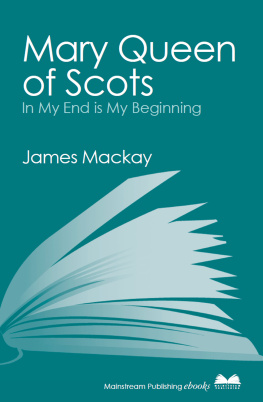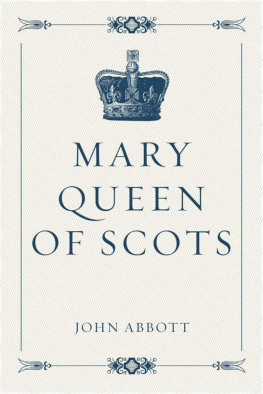C. A. Campbell - Mary Queen of Scots in History
Here you can read online C. A. Campbell - Mary Queen of Scots in History full text of the book (entire story) in english for free. Download pdf and epub, get meaning, cover and reviews about this ebook. year: 2014, publisher: Duke Classics, genre: Art. Description of the work, (preface) as well as reviews are available. Best literature library LitArk.com created for fans of good reading and offers a wide selection of genres:
Romance novel
Science fiction
Adventure
Detective
Science
History
Home and family
Prose
Art
Politics
Computer
Non-fiction
Religion
Business
Children
Humor
Choose a favorite category and find really read worthwhile books. Enjoy immersion in the world of imagination, feel the emotions of the characters or learn something new for yourself, make an fascinating discovery.
- Book:Mary Queen of Scots in History
- Author:
- Publisher:Duke Classics
- Genre:
- Year:2014
- Rating:4 / 5
- Favourites:Add to favourites
- Your mark:
- 80
- 1
- 2
- 3
- 4
- 5
Mary Queen of Scots in History: summary, description and annotation
We offer to read an annotation, description, summary or preface (depends on what the author of the book "Mary Queen of Scots in History" wrote himself). If you haven't found the necessary information about the book — write in the comments, we will try to find it.
Dozens, if not hundreds, of scholarly works, biographies, and even fictionalized novels have been based on the dramatic life of Mary Queen of Scots, who ruled over both her native Scotland and France before her execution at age 44. This volume sets itself apart from the pack in two important respects: it presents the by now well-known facts about Marys life in a compact, capsule format and then focuses on more interesting questions about her impact and influence on other historical events, both during her lifetime and for centuries after her demise.
Mary Queen of Scots in History — read online for free the complete book (whole text) full work
Below is the text of the book, divided by pages. System saving the place of the last page read, allows you to conveniently read the book "Mary Queen of Scots in History" online for free, without having to search again every time where you left off. Put a bookmark, and you can go to the page where you finished reading at any time.
Font size:
Interval:
Bookmark:

First published in 1903
ISBN 978-1-62013-598-3
Duke Classics
2014 Duke Classics and its licensors. All rights reserved.
While every effort has been used to ensure the accuracy and reliability of the information contained in this edition, Duke Classics does not assume liability or responsibility for any errors or omissions in this book. Duke Classics does not accept responsibility for loss suffered as a result of reliance upon the accuracy or currency of information contained in this book.
Much as has been written about Mary Queen of Scots, it would bedifficult to find in our language a biography of her that recommendsitself to busy readers by its brevity, whilst furnishing data andarguments with respect to controverted points in her history, intendedto give satisfaction to inquiring minds.
If the present work has done thus much, it has accomplished the aim of
THE AUTHOR.
HALIFAX, N.S., February 8th, 1902.
No tale of romance possesses a more lasting charm than does the simplehistory of Mary Stewart, Queen of Scots. Since the day on which SirRalph Sadler, Ambassador of Queen Elizabeth, was privileged to see herin the nursery at Linlithgow, and pronounced her a "right fair andgoodly child," every fresh contribution to her history has been welcomedwith unparalleled eagerness. Nor is there any indication that herlife-story will lose its fascination with the lapse of time. Scarcely ayear passes away that does not see a considerable addition made to thealready ponderous store of Mary-Stewart literature. Nevertheless, verymany even of her admirers have, to say the least, an inadequateknowledge of her life. They know her only as a heroine of romance, oras a pious widow, kneeling in devotion with the Rosary hanging at hergirdle, or as a cheerful martyr resigning her head to the block; andthey forget that for seven years she reigned over the most turbulentnation of Europe, that she opened and closed parliament, deliberated inthe Council Chamber, led armies to the field, that, in a word, she liveda most real and stirring life.
I confess it is no easy task to present a complete and, at the sametime, correct picture of her career. The difficulty is owing to thelarge amount of matter, written in different and contradictory spirits,with which some of the most important events of her life have beenobscured. Religion, politics, patriotism, avarice, personal friendshipsand hatreds, either conjointly or individually, determined the actionsof those who had part in framing the history of the period. It becomesnecessary, therefore, to learn how far the men on whose testimony, orfrom whose conduct, we have to pass judgment on certain incidents inMary's life, were influenced by one or other of these motives.
Mary Queen of Scots was born in Linlithgow Palace, in Scotland, on the8th of December, 1542. The condition of Scotland at the time was sad andevil-boding. Her father, the well-beloved James V., was at Falkland,dying of a broken heart, in consequence of the humiliating conduct ofthe disaffected Scottish nobles at Solway Moss. When told that adaughter had been born to him at Linlithgow, he gave no sign ofpleasure, but sadly said, "God's will be done." Then, his memoryreverting to the person through whom the Stewarts had ascended thethrone of Scotland, he added, "It (the crown) came with a lass and itwill go with a lass." He died shortly after, in the thirty-first yearof his age, leaving to his distracted country an infant queen, only sixdays old.
The care of the young queen devolved on her mother, Mary of Lorraine, alady of the famous French house of Guise. Did the scope of the presentsketch but sanction the digression, I should be pleased to dwell alittle on the character of this distinguished woman, whose memory somehistorians have, according to their custom, endeavoured to blacken, butwho stands out in the judgment of the best historians of every creed asa generous, forgiving and heroic woman, who conscientiously defended therights of her daughter and maintained the laws of Scotland, until anedifying and pathetic death withdrew her from the troubled scenes inwhich the years of her widowhood had been passed.
It is the privilege, or perhaps the misfortune, of rulers, that theirmarriage is one of the first things that engage the attention of theirpeople; and while the nursery was disturbed by the cries of the infantqueen, the councils of England and Scotland were agitated with thequestion of her marriage. Henry VIII., of England, had an infant son,Edward, afterwards Edward VI., for whom he wished to secure from theScottish parliament a solemn promise of marriage with the young Queen ofScots. As might be presumed, it was not so much the desire ofcultivating the friendship of his northern neighbours that actuated theEnglish monarch, as the hope of accomplishing, by means of a marriage,what his predecessors had failed to accomplish by means of the sword,the subjugation of the Scottish kingdom. To have a clear conception ofthe political relations between the two countries, and to understand thefoundation of the English claims, it will be necessary to take aretrospective glance at the history of Scotland.
In 844, the Scots of Dalriada and various Pictish races became unitedunder King Kenneth McAlpine. During the reign of Malcolm I., whoascended the throne of Alban a hundred years later, the district ofCumberland was, by Edmund of England, made over to the King of Scotland,on condition that the latter should, in return, render him certainassistance in time of war. The acquisition of other districts frontingthe Scottish border was subsequently made, in return for offeredassistance against the common enemythe Danes. But the annexation ofCumberland was the principal source of the endless conflicts between thesister kingdoms, until the union of the crowns under James VI. Forthose possessions which he had acquired within the kingdom of England,the Scottish king was obliged to pay homage to his neighbouring monarch.In the course of time, however, the English Kings began to claim thatthe homage they received from Scotland was for the entire Scottishkingdom, as well as for the Scottish possessions within the Englishborders. This the Scots denied, protesting that, while paying homagefor the English border lands which they had acquired, they were a freeand independent people. Such a state of affairs may seem strange to us,but it was nothing uncommon in those feudal times. William theConqueror, for instance, although independent sovereign of England, paidhomage to the King of France for the dukedom of Normandy, which he heldwithin French territory.
In those circumstances, any English king who might desire to make waragainst Scotland could always put forward the old claim as a plea forhis action. Unfortunately, the Scottish parliament, in order to securethe release of their King, William the Lion, on one occasionacknowledged the English claim of suzerainty. A few years later,however, Richard the Lion-hearted renounced the English claim, onpayment by Scotland of a certain sum of money, which that chivalrouscrusader needed to defray the expenses of his expedition to the HolyLand. The country remained independent for about one hundred years;then disputes concerning the rightful successor to Alexander III. havingdisunited and weakened the Scottish people, Edward I. found the timeopportune for renewing the old claim. Twelve competitors for the throneappeared in the field, who, being not altogether averse to sacrificingnational honour to personal advantage, were willing to acknowledge thesupremacy of England, in order to win the invaluable influence of Edwardfor their respective causes. The principal claimants were RobertBrucenot the great Bruceand John Baliol. Edward decided in favour ofBaliol, who forthwith ascended the throne as vassal of England. But theScottish lion was soon aroused by the encroachments of Edward, andBaliol was forced to disclaim allegiance to his patron. Entering into aleague with France, he began to prepare for the invasion of England.(This was the beginning of the long-continued friendship betweenScotland and France, which completely died out only with the death ofthe Stewart cause.) But Scotland was not prepared to cope with thehaughty Longshanks, and it was reduced to the condition of a province ofEngland. This could not endure long. Disunion, and not lack of nationalvalour, had opened the way to defeat. A leader only was needed, and aleader soon arose in the person of William Wallace, the soldier andhero-patriot. Although Wallace, after having driven the English out ofhis country, did not succeed in establishing her independence on alasting basis, nevertheless his achievements were not vain; he hadaroused his countrymen to action, and his patriotic conduct before theEnglish judges in Westminster Hall, could not fail to open the eyes ofcertain Scottish nobles who, from motives of self-interest, had acceptedthe foreign rule, to a realization of their dishonourable position.When accused of being a traitor to King Edward, Wallace replied: "Icould not be a traitor to Edward, for I was never his subject."
Font size:
Interval:
Bookmark:
Similar books «Mary Queen of Scots in History»
Look at similar books to Mary Queen of Scots in History. We have selected literature similar in name and meaning in the hope of providing readers with more options to find new, interesting, not yet read works.
Discussion, reviews of the book Mary Queen of Scots in History and just readers' own opinions. Leave your comments, write what you think about the work, its meaning or the main characters. Specify what exactly you liked and what you didn't like, and why you think so.












